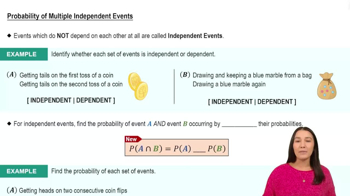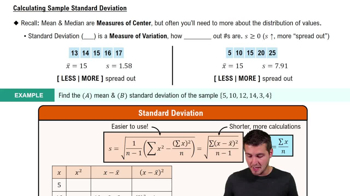46.5% of all registered voters in a country are registered democrats. Is this a parameter or a statistic?
Table of contents
- 1. Intro to Stats and Collecting Data1h 14m
- 2. Describing Data with Tables and Graphs1h 55m
- 3. Describing Data Numerically2h 5m
- 4. Probability2h 16m
- 5. Binomial Distribution & Discrete Random Variables3h 6m
- 6. Normal Distribution and Continuous Random Variables2h 11m
- 7. Sampling Distributions & Confidence Intervals: Mean3h 23m
- Sampling Distribution of the Sample Mean and Central Limit Theorem19m
- Distribution of Sample Mean - Excel23m
- Introduction to Confidence Intervals15m
- Confidence Intervals for Population Mean1h 18m
- Determining the Minimum Sample Size Required12m
- Finding Probabilities and T Critical Values - Excel28m
- Confidence Intervals for Population Means - Excel25m
- 8. Sampling Distributions & Confidence Intervals: Proportion1h 12m
- 9. Hypothesis Testing for One Sample3h 29m
- 10. Hypothesis Testing for Two Samples4h 50m
- Two Proportions1h 13m
- Two Proportions Hypothesis Test - Excel28m
- Two Means - Unknown, Unequal Variance1h 3m
- Two Means - Unknown Variances Hypothesis Test - Excel12m
- Two Means - Unknown, Equal Variance15m
- Two Means - Unknown, Equal Variances Hypothesis Test - Excel9m
- Two Means - Known Variance12m
- Two Means - Sigma Known Hypothesis Test - Excel21m
- Two Means - Matched Pairs (Dependent Samples)42m
- Matched Pairs Hypothesis Test - Excel12m
- 11. Correlation1h 6m
- 12. Regression1h 50m
- 13. Chi-Square Tests & Goodness of Fit1h 57m
- 14. ANOVA1h 57m
1. Intro to Stats and Collecting Data
Intro to Stats
Problem 9.7
Textbook Question
Body Temperatures Listed below are body temperatures from six different subjects measured at two different times in a day (from Data Set 5 “Body Temperatures” in Appendix B).
a. Are the two sets of data independent or dependent? Explain.
[Image]
 Verified step by step guidance
Verified step by step guidance1
Identify the nature of the data: The problem involves body temperatures measured from the same subjects at two different times in a day.
Understand the concept of dependent and independent data: Dependent data (or paired data) means that the data points are related or paired in some way, such as measurements taken from the same subject at different times. Independent data means that the data points are not related or paired.
Analyze the data collection method: Since the body temperatures are measured from the same subjects at two different times, the data points are paired. This means that each subject's temperature at one time is related to their temperature at another time.
Conclude the relationship: Based on the analysis, the two sets of data are dependent because they involve repeated measurements from the same subjects.
Explain the implication: Understanding that the data is dependent is crucial for choosing the correct statistical test for analysis, such as a paired t-test, which is used for comparing two related samples.
 Verified video answer for a similar problem:
Verified video answer for a similar problem:This video solution was recommended by our tutors as helpful for the problem above
Video duration:
2mPlay a video:
Was this helpful?
Key Concepts
Here are the essential concepts you must grasp in order to answer the question correctly.
Independent vs. Dependent Samples
Independent samples are those where the observations in one sample do not affect or relate to the observations in another. Dependent samples, also known as paired samples, involve observations that are related or matched in some way, such as measurements taken from the same subjects at different times. In this context, since the body temperatures are measured from the same subjects at two different times, the data sets are dependent.
Recommended video:

Probability of Multiple Independent Events
Paired Sample Analysis
Paired sample analysis is used when comparing two related samples, such as measurements taken from the same subjects under different conditions. This analysis accounts for the natural pairing of the data, allowing for more accurate comparisons by considering the differences within each pair. In the given question, since the body temperatures are measured from the same individuals at two different times, a paired sample analysis would be appropriate.
Recommended video:

Sampling Distribution of Sample Proportion
Repeated Measures Design
A repeated measures design involves collecting multiple measurements from the same subjects over time or under different conditions. This design helps control for individual variability, as each subject serves as their own control. In the context of the question, the body temperatures are measured at two different times for the same subjects, indicating a repeated measures design, which is crucial for understanding the dependency between the data sets.
Recommended video:
Guided course

Calculating Standard Deviation

 2:13m
2:13mWatch next
Master Introduction to Statistics Channel with a bite sized video explanation from Patrick
Start learningRelated Videos
Related Practice
Multiple Choice
